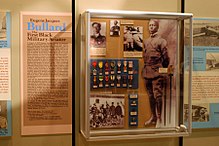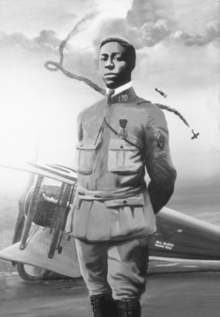Eugene Bullard

Eugene Jacques Bullard (born October 9, 1894 in Columbus , Georgia , † October 12, 1961 in New York City ) was the first African American fighter pilot .
biography
Eugene Jacques Bullard was born in Columbus, Georgia in the United States . His father was known by the name "Big Chief Ox" and his mother was a Creek tribe . They had ten children. To escape racism , Bullard boarded a ship en route to Scotland (he would later claim that as a child he witnessed his father narrowly escaping lynching ).
During his stay in Great Britain he worked as a boxer and in a music hall . On a trip to Paris he decided to stay there. After the outbreak of World War I , he joined the Foreign Legion on October 19, 1914 . (Matricule 19 / 33.717) He was assigned to the 3rd March Regiment of the 1 er régiment etranger and immediately sent into action. On June 13, 1915 he was transferred to the 2nd March Regiment of the 1 er régiment etranger and then to the 170 e régiment d'infanterie de ligne . He fought on the Somme and in the Battle of Verdun , where he was badly wounded in the thigh on March 5, 1916. He was awarded the Croix de guerre . Relocated to the Lafayette Escadrille of the Aéronautique Militaire , he finally came to the SPA 93 on August 27, 1917. He participated in over twenty combat missions, with one or two kills attributed to him (sources differ). However, the French authorities were unable to confirm Bullard's victories.
When the United States entered the war, the US Army Air Service established a medical commission in August 1917 with the aim of recruiting Americans for service in the Lafayette Escadrille. Since blacks were not allowed to fly for the US Army Air Service at the time, Bullard was not accepted even though he passed medical tests. After a fight with another soldier while he was off duty, he was transferred back to his main regiment, 170 e régiment d'infanterie, on January 11, 1918 . He served until the armistice in the Camp de La Fontaine du Berger near Orcines , in the Puy-de-Dôme .
After the war, Bullard stayed in Paris. He became a drummer and played in jazz bands . Then he began to work in the most prestigious nightclubs in Montmartre , changed to the role of club manager and eventually owned his own establishment, under Le Grand Duc on Place Pigalle . He married the daughter of a French countess. The marriage soon ended in divorce. Bullard received custody of his two daughters. He had many famous friends through his nightclub work, including Josephine Baker , Louis Armstrong, and Langston Hughes . When the Second World War broke out in 1939, Bullard, who spoke German, agreed to spy on German agents visiting his club in Paris for the French defense.
After the German invasion of the Third French Republic , Bullard fled with his daughters to the south of France in 1940. In Orléans , he joined a group of soldiers defending the city. During the fighting he suffered an injury to his spine. A French spy helped him escape to Spain , and in July 1940 he returned to the United States.
Bullard spent some time in a New York clinic because of his spinal injury, but never fully recovered. During and after World War II, while looking for work in the United States, he found that the fame he enjoyed in France had not followed him to New York. He worked in a variety of occupations, as a perfume salesman, security guard and translator for Louis Armstrong. However, his activities were very limited due to his back injury. For some time he tried to get his nightclub back in Paris, but his property had been destroyed during the German occupation. He received compensation from the French government which enabled him to buy an apartment in Harlem .
In the 1950s he was a relatively stranger to his own homeland. His daughters were married and he lived alone in his apartment, which was decorated with pictures of famous people he had known and a framed box containing his 15 war medals. Most recently he worked as an elevator operator at Rockefeller Center , where his fame as the "Black Swallow of Death" was unknown.
In 1954, the French government invited Bullard to Paris to relight the eternal light at the tomb of the unknown soldier under the Arc de Triomphe together with two French people . In 1959 he was made a Knight of the Legion of Honor . Yet he spent the last years of his life in relative oblivion and poverty in New York City . He died of stomach cancer on October 12, 1961. He was buried by French officers with military honors in the French War Veterans Section of Flushing Cemetery in Queens, New York .
legacy
His exploits were published in the 1972 book The Black Swallow of Death: The Incredible Story of Eugene Jacques Bullard, The World's First Black Combat Aviator by PJ Carisella, James W. Ryan, and Edward W. Brooke (Marlborough House, 1972). This book, whose cover was designed by famous cartoonist George Evans , is part of the Bullard exhibit at the National Museum of the United States Air Force .
On August 23, 1994, 33 years after his death and 77 years after being rejected by the US Army Air Service, Eugene Bullard was posthumously promoted to second lieutenant in the United States Air Force .
In 2006 the film Flyboys portrayed Bullard and his comrades from the Lafayette Escadrille in a very free way. Abdul Salis played the role of Eugene Skinner, whose character is based on Bullard.
French historian Claude Ribbe wrote a book in 2012 and directed a TV documentary about Eugene Bullard in 2013.
Awards
- Knight of the French Legion of Honor
- French military medal
- Croix de guerre
- Volunteer's Cross ( Croix du combattant volontaire )
- Wounded badge
- WWI commemorative medal
- WWI Victory medal
- Medal of the Free French Armed Forces
- WWII commemorative medal
Individual evidence
- ^ Bailey, Frank W., and Christophe Cony. French Air Service War Chronology, 1914–1918: Day-to-Day Claims and Losses by French Fighter, Bomber and Two-Seat Pilots on the Western Front. London: Grub Street, 2001. ISBN 978-1-902304-34-2
- ^ Ekkehard Jost Jazz stories from Europe. Wolke, Hofheim am Taunus 2012, ISBN 978-3-936000-96-2 , p. 38.
- ^ Eugene Bullard by Claude Ribbe (in French) Paris, Le Cherche Midi, 2012
- ^ Eugene Bullard TV documentary trailer
literature
- James Norman Hall , Charles Bernard Nordhoff (Eds.): The Lafayette Flying Corps. 2 volumes. Houghton Mifflin Company, Boston MA / New York NY 1920.
- Herbert Molloy Mason, Jr .: High Flew the Falcons. The French Aces of World War I. JB Lippincott Company, New York NY 1965.
- PJ Carisella, James W. Ryan: The Black Swallow of Death. The Incredible Story of Eugene Jacques Bullard, The World's First Black Combat Aviator. Marlborough House, Boston MA 1972.
- Craig Lloyd: Eugene Bullard. Black expatriate in Jazz-Age Paris. University of Georgia Press, Athens GA et al. 2000, ISBN 0-8203-2192-3 .
- Ribbe, Claude Eugène Bullard: récit . Paris, Le Cherche Midi, 2012.
Web links
- National Museum of the United States Air Force: Eugene Jacques Bullard
- New Georgia Encyclopedia : Eugene Bullard
- American volunteer in the French Foreign Legion: Eugene Bullard
- Eugene Bullard in the database of Find a Grave (English)
| personal data | |
|---|---|
| SURNAME | Bullard, Eugene |
| ALTERNATIVE NAMES | Bullard, Eugene Jacques (full name) |
| BRIEF DESCRIPTION | first African American military pilot |
| DATE OF BIRTH | October 9, 1894 |
| PLACE OF BIRTH | Columbus , Georgia |
| DATE OF DEATH | October 12, 1961 |
| Place of death | New York City |



